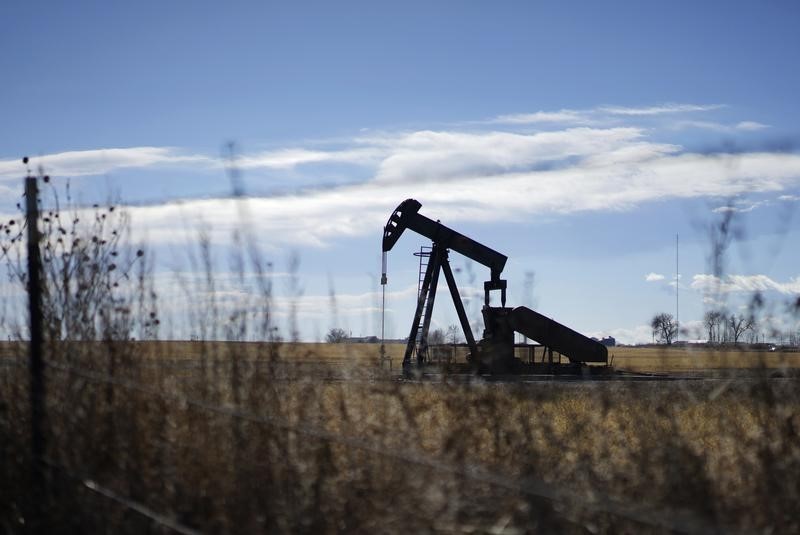By Jonathan Leff
(Reuters) - At least half a dozen U.S.-focused energy firms say they will pump more oil and gas this year than initially expected, adding to a sense that eager drillers are quickly pivoting from months of retrenchment toward renewed growth.
A closer look at the figures, however, suggests upgrades to their full-year output forecasts reflect minor adjustments rather than an emerging trend. At most they add up to around 50,000 barrels per day (bpd), according to data compiled by Reuters. On the low end, they might be shy of 20,000 bpd.
They came from companies as large as Occidental Petroleum (N:OXY), which pumped nearly 200,000 bpd or over 2 percent of U.S. crude in the first quarter, and as small as Carrizo Oil & Gas Inc. (O:CRZO), which produced about a tenth as much.
To be sure, brighter outlooks were not the norm. Bellwether shale firms including EOG Resources (N:EOG) and Whiting Petroleum Corp (N:WLL) maintained production forecasts from earlier this year, sticking to modest growth rates that vary from near flat to 25 percent.
"Those are the exceptions that prove the rule," says Pavel Molchanov, analyst at Raymond James Financial Inc. in Houston.
He said the revisions may reflect slightly better operations than expected, not a shift to deploying more rigs. "That would be very bizarre indeed."
After growing at a rate of some 1 million bpd for the past three years, U.S. oil production is set to rise by about half as much this year, according to the Energy Information Administration's April forecast. After growing in the first quarter, output is expected to peak for the year this month.
While the upside output surprises may be less than surprising, there are other signs that drillers may be turning the corner after the deepest slump in a generation.
Asked at what price he might put more oil rigs to work, Continental Resources (N:CLR) CEO Harold Hamm told analysts last week that "$70 (£45.24) a barrel is a price that turns it on for us." Those sentiments echoed several other executives.
On Friday, data showed that the number of rigs drilling in the Permian Basin rose last week for the first time this year.
PRODUCTIVITY OR...
At least in part, the upward revisions appear to be the result of surprisingly good productivity from shale wells, greater efficiency and an unexpectedly big fall in costs.
Devon Energy Corp. (N:DVN), which pumped 272,000 bpd of oil in the first quarter, revised its 2015 oil growth to 25-35 percent versus a previous 20-25 percent, while also cutting its capital and lease cost estimate by over $400 million.
"We did a great job of accelerating cost savings across our portfolio, with field level operating costs coming in well below our guidance," President and CEO John Richels told analysts. A spokesman declined to offer more details on where those additional production gains would come from.
Oxy said oil and gas production would be 20,000 barrels of oil equivalent per day (boepd) higher than earlier forecasts even as capex comes in below it a planned $5.8 billion.
However, outperformance in the Permian Basin, the West Texas oil patch that fuelled Oxy's strong first-quarter rise, only accounted for a small share of that gain, executives said. It now expects to pump 105,000-108,000 boepd from the Permian this year, up from an earlier 100,000 boepd estimate.
The revision stemmed from "incredible execution on the part of our teams to get the wells on faster," Vicki Hollub, president of Oxy's oil and gas business, told analysts. Hollub was also named last week as the successor to CEO Stephen Chazen, becoming the first woman to head a major U.S. oil firm.
The company offered no further insight on the revision, but said the Al Hosn gas project in the United Arab Emirates accounted for much of the overall growth in output this year.
Molchanov also said some companies may experience higher reported oil production volumes due to the impact of low prices on production-sharing contracts. It was unclear how this affected bigger producers like Oxy and Devon.
Some revisions were barely noticeable.

Noble Energy (N:NBL) said it was raising full-year oil and gas guidance to 300,000 to 315,000 boepd following a strong first quarter, effectively adjusting the bottom end of its initial range of 295,000 to 315,000 boepd issued Feb. 19.